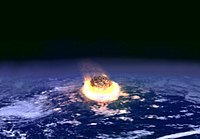
Photo from wikipedia
We present the first clear observational connection between interplanetary shock impact angles and magnetospheric ultralow frequency (ULF) wave activity. We perform a comparative study of two solar wind shocks with… Click to show full abstract
We present the first clear observational connection between interplanetary shock impact angles and magnetospheric ultralow frequency (ULF) wave activity. We perform a comparative study of two solar wind shocks with relatively similar strengths, but one being nearly frontal and, the other, highly inclined. We utilize multipoint observations with magnetometers based in space and on the ground for comparisons. For satellites and ground stations occupying similar local time positions, we find that the ULF waves have larger amplitudes and tend to be more narrowband in the case of the nearly head‐on impact, confirming previous simulation results. Additionally, we provide evidence that, due to their symmetric compression nature, nearly frontal shocks can excite only odd mode waves, while asymmetric compressions caused by inclined shocks can excite both odd and even mode waves. These results suggest that shock impact angles play crucial roles in mediating ULF wave‐particle interactions in the inner magnetosphere.
Journal Title: Geophysical Research Letters
Year Published: 2020
Link to full text (if available)
Share on Social Media: Sign Up to like & get
recommendations!